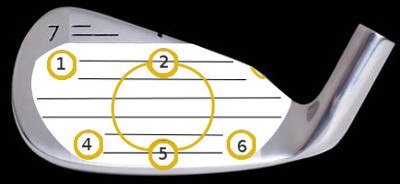Valuable Range Work Techniques

Many amateur golfers don’t have the time available in their personal schedule to get out on the course as much as they would like. Even if you love the game, you may only be able to play once or twice per month, and even less during the off-season. If this is the case for you, it’s going to be difficult to notice any ball striking patterns with so few rounds to use for data collection. Fortunately, there is another option. You can gather information on the driving range instead of the course, allowing you to rack up a high volume of shots in a short period of time.
There is one problem with this plan, however – you may not get any markings on your clubs when hitting balls on the range. If you practice on a grass range, the grass is likely cut too short to get trapped on the face at impact. You can still get some tee marks on your driver, but you’ll be in bad shape for iron shots. The news is even worse for players who have to practice at driving ranges with artificial mats rather than a grass tee line. There is no grass on the range to catch on your club, and the rubber tees in the mats probably won’t leave any kind of mark.
So, what do you do? Turn to face tape. Face tape, or impact tape, is a simple product which can be affixed to the face of your golf club before you make a swing. When you contact the ball, a mark will be left on the tape, so you have visual proof of where on the face you are making contact. You may be able to find this product at your local golf shop, and if not, you should easily be able to find it online. A roll of this kind of tape is relatively inexpensive, and should last you a while.
The process here is simple. Once you have acquired some impact tape, place a piece on one of your clubs and hit a few shots down the range. Check the face after each swing to see where you contacted the ball. Hopefully, there will be a cluster of marks right around the sweet spot of the club. If so, you will know that you are doing a good job of making solid contact. If not, you obviously have some work to do. With the marks right there on the tape for you to see, spotting a pattern in your swings will be as easy as possible.
While impact tape is a helpful product, it is not perfect. One notable drawback is the fact that your ball flight probably will be affected on shots where the tape is in use. This isn’t necessarily a big deal – you are only on the range, after all – but it is something to keep in mind. If the shots you hit while the tape is on your club look a little funny, don’t worry. Once you have done your work and you take the tape off of the club, your ball flight should go back to normal.
Even if you do use impact tape during practice sessions to evaluate your swing, it’s still a good idea to check the marks on your clubs during actual rounds of golf. Your swing may change from the range to the course, so you’ll want to monitor what is happening under actual on-course conditions. Between the information you pick up on the range and the monitoring you perform on the course, it should be easy to develop a profile of your overall ball striking prowess.





